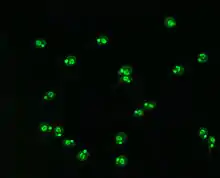Crithidia
Crithidia is a genus of trypanosomatid Euglenozoa. They are parasites that exclusively parasitise arthropods, mainly insects. They pass from host to host as cysts in infective faeces and typically, the parasites develop in the digestive tracts of insects and interact with the intestinal epithelium using their flagellum. They display very low host-specificity and a single parasite can infect a large range of invertebrate hosts.[3] At different points in its life-cycle, it passes through amastigote, promastigote, and epimastigote phases; the last is particularly characteristic, and similar stages in other trypanosomes are often called crithidial.
| Crithidia | |
|---|---|
 | |
| Crithidia luciliae (immunofluorescence pattern). | |
| Scientific classification | |
| Domain: | Eukaryota |
| (unranked): | Excavata |
| (unranked): | Discoba |
| Superphylum: | Discicristata |
| Phylum: | Euglenozoa |
| Subphylum: | Glycomonada |
| Class: | Kinetoplastea |
| Subclass: | Metakinetoplastina |
| Order: | Trypanosomatida |
| Family: | Trypanosomatidae |
| Genus: | Crithidia Léger, 1902[1] |
| Species | |
| |
The etymology of the genus name Crithidia derives from the Ancient Greek word κριθίδιον (krithídion), meaning "small grain of barley".[4][5]
Species
- Crithidia bombi is perhaps the most well documented species and is the most prevalent parasite of bumblebees, including common species like Bombus terrestris, Bombus muscorum, and Bombus hortorum.[6][7] The parasites negatively impact reproductive fitness of Bombus queens, as they affect their ovarian development as well as early colony establishment after the queens emerge from hibernation.[8]
- Crithidia mellificae is a parasite of the bee.
- Crithidia brevicula might incorporate species of the genus Wallaceina (Wallaceina brevicula, W. inconstans, W. vicina, and W. podlipaevi) as suggested by molecular phylogenies based on 18S ribosomal RNA and glycosomal glyceraldehyde-3-phosphatedehydrogenase sequences.[9]
- Other species include C. fasciculata, C. deanei, C. desouzai, C. oncopelti, C. guilhermei and C. luciliae.
- C. deanei is atypical of the Crithidia genus, and it has been argued not a member of the Crithidia at all. It is not typical of trypanosomatids because of its unusual shape and it harbours endosymbiotic bacteria.[10] C. luciliae is the substrate for the antinuclear antibody test used to diagnose lupus and other autoimmune disorders
Impact on bees
These parasites may be at least partially responsible for declining wild bee populations. They cause the bees to lose their ability to distinguish between flowers that contain nectar and those that don't. They make many mistakes by visiting nectar scarce flowers and in so doing, slowly starve to death. Commercially bred bees are used in greenhouses to pollinate plants, for example tomatoes, and these bees typically harbor the parasite, while wild bees do not. It is believed that the commercial bees transmitted the parasite to wild populations in some cases. They escape from the greenhouses through vents; a simple mesh could help prevent this.[11]
Bibliography
- Léger, Louis. 1902. Sur un flagellé parasite de l'Anopheles maculipennis. Compt. Rend. Soc. Biol., 54: 354-356, .
- "Crithidia - Overview - Encyclopedia of Life". eol.org. Retrieved 18 August 2016.
- Boulanger; et al. (2001). "Immune response of Drosophila melanogaster to infection of the flagellate parasite Crithidia spp". Insect Biochemistry and Molecular Biology. 31 (2): 129–37. doi:10.1016/S0965-1748(00)00096-5. PMID 11164335.
- Bailly, Anatole (1981-01-01). Abrégé du dictionnaire grec français. Paris: Hachette. ISBN 978-2010035289. OCLC 461974285.
- Bailly, Anatole. "Greek-french dictionary online". www.tabularium.be. Retrieved April 14, 2020.
- Runckel, Charles; DeRisi, Joseph; Flenniken, Michelle L. (2014-04-17). "A Draft Genome of the Honey Bee Trypanosomatid Parasite Crithidia mellificae". PLoS ONE. 9 (4): e95057. Bibcode:2014PLoSO...995057R. doi:10.1371/journal.pone.0095057. PMC 3990616. PMID 24743507.
- Baer, B. and P. Schmid-Hempel (2001). "Unexpected consequences of polyandry for parasitism and fitness in the bumblebee, Bombus terrestris". Evolution. 55 (8): 1639–1643. doi:10.1554/0014-3820(2001)055[1639:ucopfp]2.0.co;2. PMID 11580023.
- Erler, Silvio; Popp, Mario; Wolf, Stephan; Lattorff, H. Michael G. (2012-05-01). "Sex, horizontal transmission, and multiple hosts prevent local adaptation of Crithidia bombi, a parasite of bumblebees (Bombus spp.)". Ecology and Evolution. 2 (5): 930–940. doi:10.1002/ece3.250. ISSN 2045-7758. PMC 3399159. PMID 22837838.
- Kostygov, Alexei Yu.; Grybchuk-Ieremenko, Anastasiia; Malysheva, Marina N.; Frolov, Alexander O.; Yurchenko, Vyacheslav (2014-09-01). "Molecular revision of the genus Wallaceina". Protist. 165 (5): 594–604. doi:10.1016/j.protis.2014.07.001. ISSN 1434-4610.
- Camargo; et al. (1992). "Ribosomal DNA restriction analysis and synthetic oligonucleotide probing in the identification of genera of lower trypanosomatids". The Journal of Parasitology. 78 (1): 40–8. doi:10.2307/3283683. JSTOR 3283683. PMID 1310733.
- Colla, Sheila R.; Otterstatter, Michael C.; Gegear, Robert J.; Thomson, James D. (2006-05-01). "Plight of the bumble bee: Pathogen spillover from commercial to wild populations". Biological Conservation. 129 (4): 461–467. doi:10.1016/j.biocon.2005.11.013.
Further reading
E Riddell, Carolyn; D Lobaton Garces, Juan; Adams, Sally (27 November 2014). "Differential gene expression and alternative splicing in insect immune specificity". BMC Genomics. 15: 1031. doi:10.1186/1471-2164-15-1031. PMC 4302123. PMID 25431190. ![]()
Otterstatter, Michael C.; Thomson, James D. (23 July 2008). "Does Pathogen Spillover from Commercially Reared Bumble Bees Threaten Wild Pollinators?". PLoS ONE. 3 (7): e2771. Bibcode:2008PLoSO...3.2771O. doi:10.1371/journal.pone.0002771. PMC 2464710. PMID 18648661. ![]()
Daniel, Cariveau; Elijah, Powell; Hauke, Koch (April 2014). "Variation in gut microbial communities and its association with pathogen infection in wild bumble bees (Bombus)". The ISME Journal. 8 (12): 2369–2379. doi:10.1038/ismej.2014.68. PMC 4260702. PMID 24763369.
External links
| Wikimedia Commons has media related to Crithidia. |
"Crithidia" at the Encyclopedia of Life